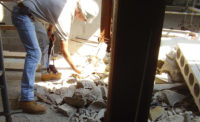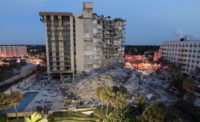Next year, European researchers plan to conclude a series of tests to integrate new technologies for rescuing survivors trapped in collapsed buildings. One test is on disproportionate-collapse simulation software created by Durham, N.C.-based structural engineering firm Applied Science International.
At a controlled demolition in Lyon, France, earlier this year, engineers used ASI’s Extreme Loading for Structures software to create a model in the field that closely predicted the shape of a collapse to come. Such a tool could help first responders to find survivors trapped in rubble. The final tests aim to determine the viability of the application.
The European Union-funded research is part of the EU’s INACHUS project, which seeks to improve the efficiency and safety of urban search and rescue in collapsed buildings. According to Steven Scoba, ASI’s chief of staff, the first tests also demonstrate how fast dynamic analysis and 3D modeling can be done in the field now.
ASI used its Extreme Loading for Structures, a nonlinear dynamic structural analysis software, to create a pre-demolition model of the target building based on site measurements and known variables from the demolition plan. Those variables changed just prior to the demolition, however, and the engineers quickly adjusted their model. “That’s kind of what disaster response is,” Scoba says. “It’s all about time.”
To create a realistic rendering of the model, a different offsite tool was used with Blender—an open-source, 3D software for modeling, rigging, animation, simulation, rendering and motion tracking.
After the demolition, two drones—one with a laser scanner and another with an optical digital camera—collected data over the collapsed building, which was compiled with a third set of data from a ground-based laser scanner. ASI’s model closely matched the rubble pile.
Jean-Luc Rey, a structural engineer and urban search-and-rescue specialist who observed the test as part of the INACHUS team, says ASI’s collapse simulation was “satisfactory, at first glance, in terms of correlation between the physical model and the numerical model. The result I saw on the spot matched at about 90%.” But more evaluation is needed, Rey says, adding, “I don’t know how to compare this solution with another because the technology used is still recent.”
Sherif El-Tawil, professor of civil and environmental engineering at the University of Michigan and head of the school’s Computational and Structural Simulation Laboratory, says he is familiar with ASI’s modeling tools and cautions against drawing conclusions too soon.
“Ninety percent. I find that hard to believe,” El-Tawil says. “It’s such an unpredictable process. Even if there was a good comparison, it could be a fluke. That said, what ASI is doing is very ambitious, and I hope they are successful.”
Creating models of existing buildings to simulate how they would collapse due to earthquakes or explosions may not be feasible, especially for older buildings, El-Tawil adds. “I have always felt that we should have a database of all buildings and the physical infrastructure that can be accessed during emergencies … or even complete models of buildings. Building information models are now making this feasible.” He cautions, however, that doing so creates other problems, such as exposure to hackers and other security issues.
ASI sells its modeler, solver and postprocessor directly in the U.S. and licenses through distributors internationally, Scoba says. Although use by demolition professionals is a recent development, “it’s kind of a new application. They don’t do a lot of engineering. There’s just not a lot of information about the building,” he says.
Adds El-Tawil, “With demolition, you have the luxury of knowing where and how strong the demolition blasts will be. You don’t have this information immediately after a real event, although you eventually will get it. But it will be too late.”
Modeling and design for progressive collapse have improved since, for example, the 1995 bombing of the A.P. Murrah Building in Oklahoma City. El-Tawil says disproportionate-collapse design standards and technologies are beginning to converge worldwide. The General Services Administration, which sets construction standards for U.S. embassies, last fall updated its building requirements to unify and clarify those standards across a wider range of federal and public buildings.
This article was amended on Oct. 13 to use the term "disproportionate collapse" instead of "progressive collapse."




